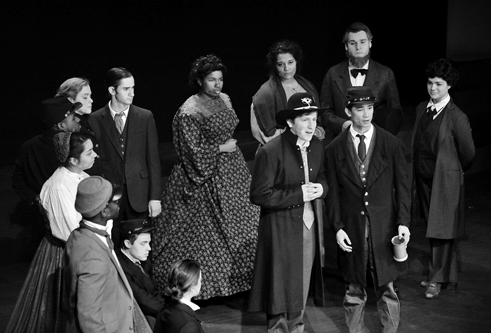Georgetown History Meets Holiday Carols in ‘Civil War Christmas’ Production

By Alix PianinCurrent Staff Writer
Abraham Lincoln shares a drink with his cabinet at a War Department Christmas party. A Union soldier struggles with his religious beliefs in the face of battle. An escaped slave and her daughter follow the constellations to a new life in Washington. Robert E. Lee spends a bitterly cold night on the ground with his troops.
No, it’s not a sequence from the new Civil War historical film “Lincoln.” It’s just a handful of the many stories that weave through “A Civil War Christmas,” a musical theater production currently running at Georgetown University.
Set in D.C. on Dec. 24, 1864, “A Civil War Christmas” follows dozens of historical and fictional characters as they reflect on their lives in wartime against a backdrop of traditional American hymns and classic Christmas carols. The show is full of recognizable D.C. landmarks — but director Nadia Mahdi sought to bring the story even closer to home.
Mahdi, a performing arts professor at Georgetown, ventured to connect the school’s own Civil War legacy to the production. With the help of university archivists, dramaturge and assistant professor Nina Billone Prieur, and student and faculty crew members, the production team found countless artifacts and firsthand accounts of the school’s rich wartime history.
“Once you start looking, you find so many allusions to the Civil War,” Mahdi said.
At what was then Georgetown College, Northern and Southern culture collided. Considered the uppermost point of the Confederacy, Georgetown had 1,500 students and alumni who were of military age when war broke out, and 1,141 fought — 216 for the North and 925 for the South. The officially neutral college continued to hold classes for its Confederate-leaning campus while simultaneously providing lodgings and hospital care for Union soldiers. Even the school colors, blue and gray, commemorate Georgetown’s division during the Civil War.
University librarians helped Billone Prieur and the crew find letters, photographs, art collections, manuscripts, rare books and banners from the Civil War-era campus. Scenic designer Robbie Hayes dove into his image archive to identify the photo that would become an icon for the play — one of Union soldiers looking across the Potomac River to the Georgetown campus.
The materials all served as cues for the show’s lighting, technical and costume designers and producers, and added a layer of Georgetown-centric history to the final production, said Billone Prieur.
What started with a play has become a larger campus retrospective. Billone Prieur and the crew collaborated to transform the university’s Gonda Theatre lobby into an interactive, multimedia exhibit. Cast members played tapes of themselves performing letters and memoirs of 1860s Georgetown students and faculty. Students from a Georgetown costume history class submitted informational recordings about historical figures featured in the show. Patrons are being encouraged to submit their own reactions to the issues prevalent in the production.
It provides a historical context for the show, Billone Prieur said, while also highlighting how inequality and violence persist today. The goal is to “ask harder questions about our living history,” she said. “This isn’t a play about sitting in hopelessness, but it needs to have an active edge.”
With so many moving parts — the show features a 16-member cast and a five-person orchestral team — Mahdi made sure to slot in a few history lessons.
Mahdi and Billone Prieur encouraged the students to consider their own connections to the show’s characters.
Some cast members had relatives who fought in the Civil War; others shared accounts of their parents’ experiences living through more recent wars. One student had found out that her family home in Pennsylvania was used as a stop on the Underground Railroad. The cast later recorded their comments, and the tape is part of the lobby exhibit.
“The idea behind the show is that in the midst of war, there are pockets of peace … windows of quiet and reflection,” Mahdi said.
Though Christmas and the Civil War may seem incongruous, Billone Prieur said she thought the play captures what holidays are about — storytelling. “It’s the time of year when we feel a connection to a larger community,” she said.
“A Civil War Christmas,” written by Pulitzer Prize-winning playwright and D.C. native Paula Vogel, is the latest installment in this year’s “Season of War and Peace” at Georgetown’s Davis Performing Arts Center. On Saturday, “A Civil War Christmas” opened to a sold-out crowd. It will continue through Dec. 8.
Performance times are 8 p.m. Thursday through Saturday and 2 p.m. Dec. 1. Tickets cost $15 to $20; call 202-687-2787 or visitperformingarts.georgetown.edu.
This article appears in the Nov. 21 issue of The Georgetown Current newspaper.





